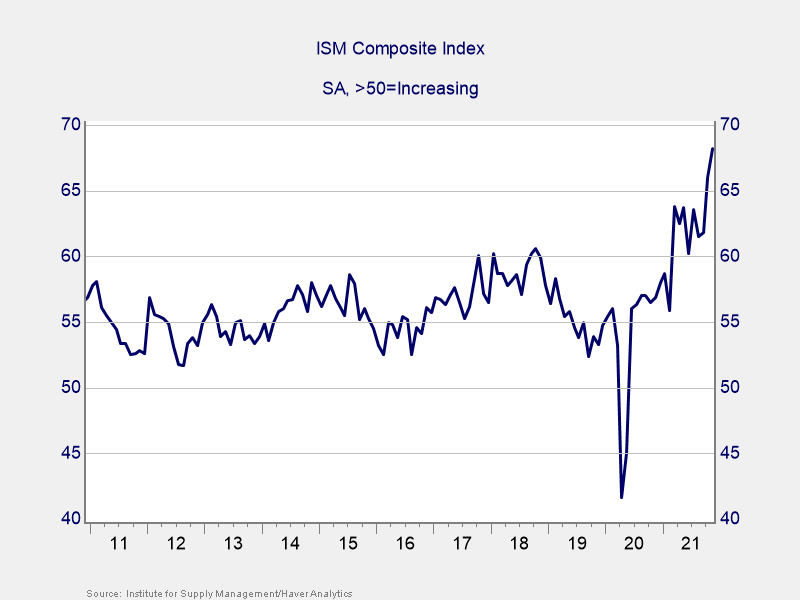Solid December Caps Off a Strong Year for Markets
Markets rallied to finish out 2021, with all three major U.S. indices notching gains for the month, quarter, and year. The S&P 500 gained 4.48 percent in December, 11.03 percent for the quarter, and 28.71 percent for the year. The Dow Jones Industrial Average (DJIA) returned 5.53 percent in December, 7.87 percent for the quarter, and 20.95 percent for the year. The Nasdaq Composite posted returns of 0.74 percent, 8.45 percent, and 22.18 percent, respectively, for the month, quarter, and year.
These results coincided with improving fundamentals throughout the course of the year. According to Bloomberg Intelligence, as of December 10, 2021, the blended earnings growth rate for the S&P 500 in the third quarter was 41.1 percent. This is notably higher than analyst estimates at the start of earnings season for a 28.4 percent increase. Over the long run, fundamentals drive market performance, so the return to earnings growth in 2021 bodes well for future performance.
Technical factors also remained supportive for markets throughout the month, quarter, and year. All three major indices finished December above their respective 200-day moving averages and have seen solid technical support since the expiration of initial lockdowns in 2020—a sign that investors remain confident in the economic recovery.
International markets had a solid December but mixed performance throughout the quarter and year. The MSCI EAFE Index gained 5.12 percent during the month, 2.69 percent for the quarter, and 11.26 percent for the year. The MSCI Emerging Markets Index experienced a 1.92 percent rise in December, a 1.24 percent decline in the fourth quarter, and a 2.22 percent decline for the year.
Technicals were mixed for international markets. The MSCI EAFE Index finished December above trend. But the MSCI Emerging Markets Index spent the entire quarter below its 200-day moving average. This weakness was due to concerns about the slowdown in Chinese growth, the country’s troubled property development sector, and the Omicron variant.
Over the course of the year, long-term interest rates began to normalize closer to pre-pandemic levels. The 10-year U.S. Treasury yield increased from 0.93 percent at the start of 2021 to 1.52 percent at year-end. This served as a headwind for investment-grade fixed income. The Bloomberg U.S. Aggregate Bond Index declined by 0.26 percent in December, gained 0.01 percent for the quarter, and fell 1.54 percent for the year.
High-yield fixed income returned a solid 1.87 percent in December, which contributed to a 0.71 percent gain for the quarter and a 5.28 percent increase for the year.
Medical Risks Rise at Year-End
We saw medical risks increase toward the end of the year, as the Omicron variant drove case growth during the month. Average daily new cases in the U.S. increased to the highest recorded level, surpassing the previous peak from January 2021.
We finished the month with 62 percent of Americans fully vaccinated and another 12 percent having received at least one shot. This reflects a notable shift from earlier in the year and indicates that Americans remain relatively well protected. Progress on the vaccine front is expected in the months ahead, which should help mitigate the potential impact of the recent rise in cases.
Economic Recovery Remains Resilient
The labor market showed signs of improvement throughout the quarter. The unemployment rate fell to 4.2 percent at the end of November (a notable improvement from the December 2020 unemployment rate of 6.7 percent), and the number of initial jobless claims fell below pre-pandemic levels.
After declining for much of the fall, consumer confidence showed signs of stabilizing at the end of the year, and consumer spending growth remained strong.
Businesses, likewise, showed signs of continued recovery. Business confidence rebounded swiftly following the expiration of initial lockdowns in 2020. It surged further in October and November 2021, reaching a new record high (see Figure 1).
Figure 1. ISM Composite Index, 2011–Present

Finally, the housing market has been a bright spot in the current economic recovery. Low mortgage rates and consumer preference for more space due to the pandemic led to a surge in prospective home buyers in 2020 and 2021. The pace of existing home sales surpassed pre-pandemic levels in November, though rising mortgage rates and prices may slow the pace of improvements in the months ahead.
Shifting Risks to Start the New Year
While the economic recovery shrugged off rising medical concerns at year-end, there are notable risks at play. The most immediate risk is political, as we saw at the end of 2021, when Congress acted to avoid another debt ceiling confrontation. Another area to monitor is the Federal Reserve’s decision to start normalizing monetary policy.
International risks include the slowdown in China and continued medical concerns, which could weigh on the global economic recovery.
While the road ahead is uncertain, we saw progress on the medical and economic fronts throughout 2021. Looking forward, we can expect to see continued growth in the months ahead due to the progress we’ve made and the relatively muted impact of the new variant on the pace of the economic recovery. As always, a well-diversified portfolio that matches investor goals and timelines remains the best path forward for most. If concerns remain, reach out to us to discuss your financial plan.
All information according to Bloomberg, unless stated otherwise.
Disclosure: Certain sections of this commentary contain forward-looking statements based on our reasonable expectations, estimates, projections, and assumptions. Forward-looking statements are not guarantees of future performance and involve certain risks and uncertainties, which are difficult to predict. Past performance is not indicative of future results. Diversification does not assure a profit or protect against loss in declining markets. All indices are unmanaged and investors cannot invest directly into an index. The Dow Jones Industrial Average is a price-weighted average of 30 actively traded blue-chip stocks. The S&P 500 Index is a broad-based measurement of changes in stock market conditions based on the average performance of 500 widely held common stocks. The Nasdaq Composite Index measures the performance of all issues listed in the Nasdaq Stock Market, except for rights, warrants, units, and convertible debentures. The MSCI EAFE Index is a float-adjusted market capitalization index designed to measure developed market equity performance, excluding the U.S. and Canada. The MSCI Emerging Markets Index is a market capitalization-weighted index composed of companies representative of the market structure of 26 emerging market countries in Europe, Latin America, and the Pacific Basin. It excludes closed markets and those shares in otherwise free markets that are not purchasable by foreigners. The Bloomberg Aggregate Bond Index is an unmanaged market value-weighted index representing securities that are SEC-registered, taxable, and dollar-denominated. It covers the U.S. investment-grade fixed-rate bond market, with index components for a combination of the Bloomberg government and corporate securities, mortgage-backed pass-through securities, and asset-backed securities. The Bloomberg U.S. Corporate High Yield Index covers the USD-denominated, non-investment-grade, fixed-rate, taxable corporate bond market. Securities are classified as high-yield if the middle rating of Moody’s, Fitch, and S&P is Ba1/BB+/BB+ or below. Authored by Brad McMillan, CFA®, CAIA, MAI, managing principal, chief investment officer, and Sam Millette, manager, fixed income, at Commonwealth Financial Network®. © 2022 Commonwealth Financial Network®





